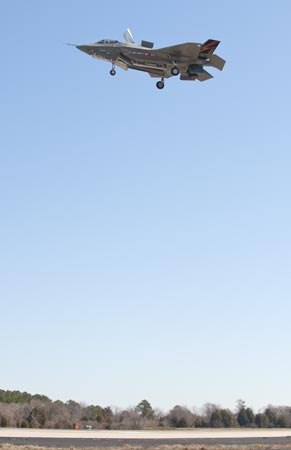 Lockheed Martin announced March 17 that the F-35B short takeoff/vertical landing (STOVL) variant had demonstrated its hover capability during a test flight at NAS Patuxent River, Md. The test, according to a company release, “confirmed predictions of the jet’s vertical thrust, stability, and control in hovering flight.” F-35 lead STOVL pilot Graham Tomlinson took off conventionally before converting to STOVL mode at 200 knots airspeed. Tomlinson then slowed the aircraft to 60 knots and flew a decelerating approach to a zero airspeed hover at 150 feet above the runway, marking the first free air hover in the F-35B. Following execution of controllability test points in the hover mode, he executed a STOVL landing at 70 knots. Later in the day, BF-1 performed the first F-35 short takeoff. Next step for the Marine Corps variant of the strike fighter is its first vertical landing.
Lockheed Martin announced March 17 that the F-35B short takeoff/vertical landing (STOVL) variant had demonstrated its hover capability during a test flight at NAS Patuxent River, Md. The test, according to a company release, “confirmed predictions of the jet’s vertical thrust, stability, and control in hovering flight.” F-35 lead STOVL pilot Graham Tomlinson took off conventionally before converting to STOVL mode at 200 knots airspeed. Tomlinson then slowed the aircraft to 60 knots and flew a decelerating approach to a zero airspeed hover at 150 feet above the runway, marking the first free air hover in the F-35B. Following execution of controllability test points in the hover mode, he executed a STOVL landing at 70 knots. Later in the day, BF-1 performed the first F-35 short takeoff. Next step for the Marine Corps variant of the strike fighter is its first vertical landing.
House, Senate Unveil Competing Proposals for 2026 Budget
July 11, 2025
Lawmakers from the House and Senate laid out competing versions of the annual defense policy bill on July 11, with vastly different potential outcomes for some of the Air Force’s most embattled programs.